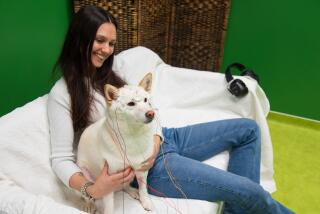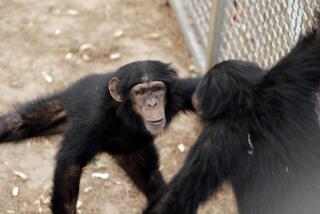Baboons can recognize written words, study finds
Baboons donât read, donât speak and perhaps canât understand language at all. But scientists have found that they can learn to recognize writing on a computer screen, identifying correctly most of the time which combinations of letters are words (âdone,â âvastâ) and which are not (âtelk,â âvirtâ).
The discovery may help explain how reading evolved in humans, researchers said, bolstering a theory that the skill first arose from animalsâ ability to distinguish objects, rather than from the uniquely human demands of verbal communication.
âMaybe we use letters to read words because weâre mimicking what we do with everyday objects,â said Jonathan Grainger, a cognitive psychologist at the National Center for Scientific Research and Aix-Marseille University in France and lead author of an article about the research published Thursday in the journal Science.
Graingerâs work generally focuses on primates of the human sort. His usual guinea pigs are university students, whom he studies to ascertain the elementary processes people use to decode individual words.
In this experiment, however, Grainger turned to baboons because he wanted to test a theory offered by some neuroscientists: Reading takes advantage of visual systems in the brain that originally evolved to identify all sorts of objects, such as trees and food. Grainger needed to see whether animals without linguistic capacity could recognize words, and study coauthor Joel Fagot runs a research facility housing 30 baboons that provided the perfect setting.
Six baboons living in an 82-by-115-foot enclosure were permitted to approach computer monitors whenever they wanted. The touch screens displayed a string of four letters, which could be a word or a non-word.
Grainger and his colleagues trained the baboons to touch the letters to initiate the test. In the next step, the letters would vanish and two response symbols would appear on the screen, either of which the baboon could opt to touch. A light blue oval on the right was the correct response for a real word, and a dark blue cross on the left was correct for a nonsense string of letters.
The baboons got a wheat reward if they pressed the correct symbol.
Grainger said that the task resembled a test he administers often to people, skilled readers who are timed as they distinguish between words and non-words.
âJoel thought it was crazy, that baboons would not do it,â he said.
In fact, the monkeys proved quite able, learning to discern dozens of words interspersed among nearly 8,000 non-words with close to 75% accuracy, the team reported.
After six weeks, the teamâs âbest baboonâ â a high achiever named Dan who is good at all kinds of things, Grainger said â had learned 308 words. After they got the idea, even words that Dan and the other baboons saw for the first time triggered significantly fewer ânon-wordâ responses than could be expected by random chance.
In other words, âItâs not just memorizing,â Grainger said. âItâs picking up what we call these statistical regularities: Certain letter combinations appear more frequently in words than in non-words.â
Michael Platt, director of the Duke Institute for Brain Science at Duke University in Durham, N.C., and author of an editorial in Science that accompanied the study, said he believed this was âthe first study of word-like recognition in a nonhuman animal.â
He compared the work to examinations of pigeonsâ ability to recognize natural objects.
âPigeons can spot an oak leaf from among many types of tree leaves, and no oak leaves are identical. They are extracting some kind of statistical pattern about whatâs an oak leaf and whatâs not an oak leaf,â he said.
âPresumably, thatâs what the baboons are doing here. They donât know the meaning of the words, but they learn that certain combinations of letters are more likely to go together than others, and that pattern allows them to generalize to new words they havenât seen before.â
Also intriguing, Platt said, was Graingerâs discovery that the more word-like a nonsense string was â the more familiar letter combinations it contained â the harder time the baboons had determining that it was a non-word.
Tests in human subjects have shown the same thing.
Seeing this in an animal other than humans âsuggests that perhaps the way [people] read is less reliant on spoken language than we had thought,â Platt said. âIt suggests that there is some more ancestral neural circuit that we co-opt to support reading.â
It also hints that dyslexia might be more of a visual processing disorder than a problem matching sounds and letters, he said.
Grainger said heâd like to test animals âlower down the scale,â such as pigeons or rats, to find whether they have similar word recognition abilities. He hopes to invent an artificial alphabet and lexicon â which would allow more precise manipulation of what is a word and what is a non-word â and repeat the experiment in baboons and humans.
It is not obvious that people would necessarily perform better in such an experiment, he said.
The baboons performed their tasks âquite happily,â apparently motivated by the wheat snack and, Grainger believes, something akin to enjoyment.
âIt could be like a video game for them,â he mused.
He said he was skeptical that humans could be persuaded so easily to take the time to learn a new alphabet.







